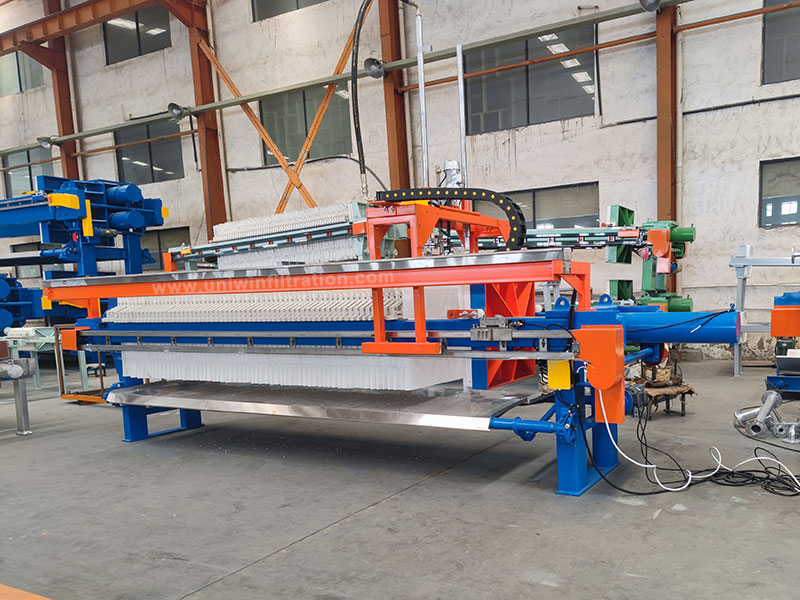What Is the Working Principle of the Automatic Filter Cloth Washing System?
The automatic filter cloth washing system is an auxiliary system used to maintain the permeability and filtration efficiency of the filter cloth. Its primary function is to regularly clean the filter cloth through automated means, preventing filter cake residue from clogging the cloth, thereby improving filter press operating efficiency and extending the service life of the filter cloth.
Filter Cloth Washing System Structure
High-pressure pump: Provides a continuous, stable high-pressure water flow and is the core of the entire cleaning system.
Spray cleaning device (track-mounted or arm-mounted): Equipped with nozzles that automatically move along both sides of the filter cloth.
Nozzle system: Mostly made of stainless steel, designed for high-impact spray and strong anti-clogging performance.
Electronic control system: Equipped with a PLC or touchscreen control panel, parameters such as cleaning frequency, spray time, and travel speed can be set.

Working Principle of the Filter Cloth Washing System
After a filter press has been running for a period of time, a large amount of filter cake residue will adhere to the filter cloth surface, which may not be completely removed even during discharge. The automatic filter cloth cleaning device is typically activated after the filter press cycle ends and the filter plates are opened. It flushes the filter cloth with high-pressure water to restore its permeability.
The cleaning process is divided into the following steps:
Automatic separation of the filter plates
Before the filter cloth cleaning begins, the filter press’s hydraulic or mechanical system separates the filter plates one by one, exposing the filter cloth.
Nozzle alignment
The nozzle system (usually a high-pressure nozzle) installed in the automatic cleaning device automatically moves to the filter cloth surface for precise alignment.

High-pressure water spraying
The system uses a high-pressure pump to evenly spray water onto the filter cloth surface through nozzles. The water flow creates a high-impact fan or cone pattern, removing filter cake residue and fine particles.
Automatic reciprocating cleaning
The spraying device reciprocates up and down along the filter cloth, ensuring complete cleaning coverage and eliminating blind spots.
Drainage and recycling
Wastewater generated during the cleaning process is collected in a sump and then discharged through drainage pipes or recycled for treatment, preventing on-site contamination.

Application Advantages
Improve work efficiency
Reduce manual cleaning frequency, saving labor costs and ensuring continuous and efficient equipment operation.
Extend filter cloth life
Promptly remove debris and particles from the filter cloth to prevent clogging and reduce replacement frequency.
Ensure filtration performance
Maintain good filter cloth permeability to ensure stable solid-liquid separation.
Supports unattended operation
Linked with the filter press’s main control system, it enables automatic cleaning cycle management, enhancing intelligence.

